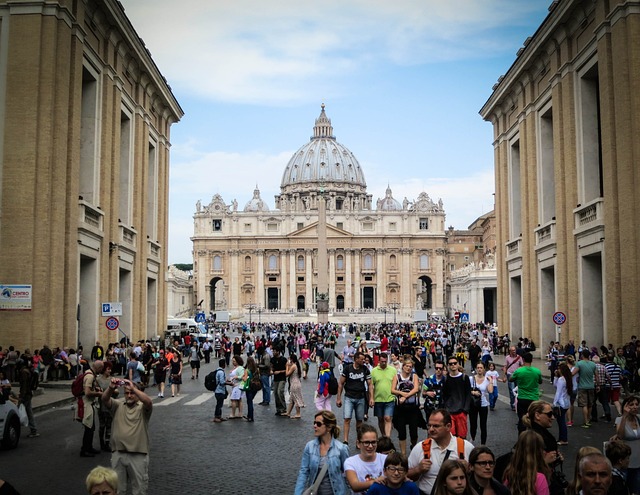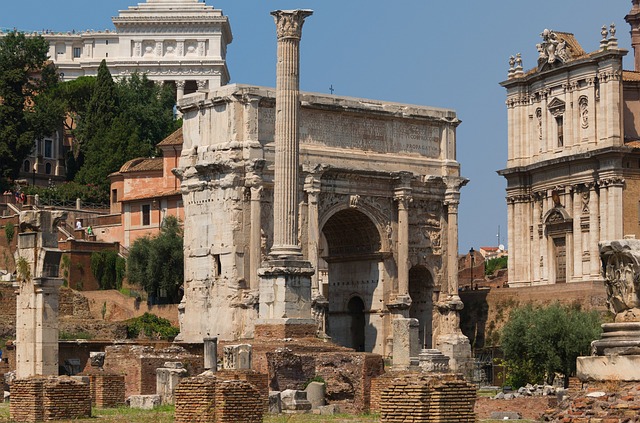From the ancient ruins of the Colosseum to the majestic splendor of the Vatican City, Rome is a city where every cobblestone street whispers tales of a bygone era. Is it the mouthwatering aroma of freshly made pasta drifting from quaint trattorias? Perhaps it’s the vibrant piazzas, alive with the chatter of locals and the melodies of street musicians. Or maybe it’s the sense of history that permeates every corner, reminding visitors that they are walking in the footsteps of emperors and gladiators, experiencing a living museum unlike any other.
Especially for visitors from the United States, the three most popular attractions in Rome, Italy are:
1. The Colosseum: An iconic symbol of ancient Rome, the Colosseum is one of the most visited landmarks in the world. American seniors are often drawn to its rich history and impressive architecture.
2. The Vatican Museums and St. Peter’s Basilica: Home to some of the world’s most renowned art collections, including Michelangelo’s Sistine Chapel ceiling, the Vatican Museums are a must-see for visitors to Rome. St. Peter’s Basilica, with its magnificent dome and beautiful interior, is also a highlight for many seniors.
3. The Roman Forum and Palatine Hill: These ancient ruins offer a glimpse into the daily life of ancient Romans. American seniors often enjoy exploring the archaeological sites and imagining what life was like in ancient Rome.
The Colosseum
Enter the grandeur of ancient Rome and behold the awe-inspiring majesty of the Colosseum, an iconic symbol of history, power, and architectural mastery. Nestled in the heart of Rome, this colossal amphitheater stands as a testament to the ingenuity and grandiosity of the Roman Empire. With a history spanning over two millennia, the Colosseum beckons travelers from across the globe to immerse themselves in its storied past and marvel at its enduring splendor.
Approaching the towering facade of the Colosseum, you are instantly transported back in time to an era of gladiators, chariot races, and epic battles. Built in the first century AD, under the emperor Vespasian, and completed in 80 AD by his son Titus, this architectural marvel was originally known as the Flavian Amphitheater. Its imposing structure, crafted from travertine limestone and concrete, once hosted spectacular events attended by thousands of spectators, eager to witness the spectacle of ancient Roman entertainment.
Once inside the Colosseum, you find yourself amidst the remnants of a bygone era. Gaze up at the towering tiers of seating, once filled with the enthusiastic cheers of Roman citizens, and imagine the roar of the crowd as gladiators faced off in fierce combat. Explore the labyrinthine corridors and chambers beneath the arena, where wild animals were housed and prisoners awaited their fate. Trace the footsteps of emperors and nobles as you wander through the ruins of this architectural wonder, and feel the weight of history pressing down upon you.
But the Colosseum is more than just a relic of the past—it is a living testament to the enduring legacy of Rome. Despite the passage of centuries and the ravages of time, this ancient amphitheater continues to captivate and inspire visitors from around the world. Its iconic silhouette dominates the skyline of modern-day Rome, serving as a poignant reminder of the city’s rich cultural heritage and storied past.
A visit to the Colosseum is an experience like no other, offering travelers a rare glimpse into the splendor and grandeur of ancient Rome. Whether you are a history buff, an architecture enthusiast, or simply a curious traveler seeking to uncover the secrets of the past, the Colosseum promises to leave an indelible impression on all who venture within its hallowed walls. So come, journey back in time and immerse yourself in the glory of the Roman Empire—discover the wonders of the Colosseum and make memories that will last a lifetime.
The Vatican Museums and St. Peter’s Basilica
The Vatican Museums and St. Peter’s Basilica stand as iconic landmarks of art, history, and spirituality, nestled within the heart of Vatican City, the smallest independent state in the world. Each is a testament to human creativity, faith, and cultural heritage, drawing millions of visitors annually from across the globe.
The Vatican Museums are a treasure trove of artistic masterpieces spanning centuries of human endeavor. Founded by Pope Julius II in the early 16th century, these museums showcase an extensive collection of artworks amassed by successive pontiffs over the centuries. From ancient Roman and Egyptian artifacts to Renaissance paintings and sculptures, the Vatican Museums offer a comprehensive journey through the evolution of Western art. Among its most renowned highlights is the Sistine Chapel, adorned with Michelangelo’s breathtaking frescoes, including the iconic ceiling depicting scenes from the Book of Genesis. Visitors marvel at the skill and vision of artists like Raphael, Leonardo da Vinci, and Caravaggio as they traverse the museum’s labyrinthine corridors and galleries.
Adjacent to the Vatican Museums stands St. Peter’s Basilica, the largest church in the world and a pinnacle of Renaissance architecture. Designed by luminaries such as Michelangelo, Gian Lorenzo Bernini, and Donato Bramante, the basilica is a testament to the grandeur of Catholicism and the power of human ingenuity. Its colossal dome dominates the skyline of Rome, a symbol of spiritual aspiration reaching towards the heavens. Pilgrims and tourists alike flock to St. Peter’s Square, the majestic plaza in front of the basilica, to admire its grandeur and soak in the aura of spirituality that permeates the air.
Inside the basilica, visitors are greeted by a wealth of religious art and sacred relics, including Michelangelo’s Pietà, a masterpiece of sculptural grace depicting the sorrowful Virgin Mary cradling the lifeless body of Jesus Christ. The ornate interior, adorned with intricate mosaics, marble columns, and gilded altars, exudes an atmosphere of reverence and awe.
Together, the Vatican Museums and St. Peter’s Basilica serve as a beacon of cultural heritage and spiritual pilgrimage, inviting visitors to delve into the depths of human creativity and devotion. Whether marveling at the artistic genius of the Renaissance masters or contemplating the mysteries of faith, a journey through these hallowed halls is sure to leave an indelible impression on the soul.
The Roman Forum and Palatine Hill
Nestled in the heart of ancient Rome lies a duo of archaeological wonders: the Roman Forum and Palatine Hill. These historic sites stand as testaments to the grandeur and legacy of the Roman Empire, offering visitors a glimpse into the rich tapestry of Roman history, politics, and culture.
The Roman Forum, once the bustling center of ancient Rome, served as the civic, religious, and commercial hub of the city. Surrounded by majestic temples, government buildings, and bustling markets, the Forum was the beating heart of Roman life for centuries. Here, citizens gathered to engage in political discourse, worship their gods in grand temples, and conduct business transactions amidst the hustle and bustle of daily life. Today, visitors stroll through the Forum’s evocative ruins, marveling at the remnants of structures such as the Temple of Saturn, the Arch of Septimius Severus, and the iconic ruins of the Senate House. Each stone and column whispers tales of Rome’s storied past, inviting modern-day travelers to immerse themselves in the echoes of ancient glory.
Perched above the Roman Forum lies Palatine Hill, one of the most ancient parts of Rome and legendary birthplace of the city itself. According to Roman mythology, this legendary hill was where Romulus founded Rome in 753 BCE. Over the centuries, Palatine Hill became a symbol of imperial power, housing the opulent palaces of Rome’s emperors and aristocracy. Visitors can wander through the sprawling ruins of imperial residences, adorned with magnificent frescoes, intricate mosaics, and sprawling gardens, offering a glimpse into the lavish lifestyle of ancient Rome’s elite. From the vantage point of Palatine Hill, panoramic views of the Roman Forum and the city below unfold, offering a breathtaking panorama that captures the essence of Rome’s timeless beauty.
Together, the Roman Forum and Palatine Hill offer a captivating journey through the annals of Roman history, where the past comes alive amidst the ruins of ancient glory. As visitors traverse the pathways of these historic sites, they are transported back in time to an era of triumphs and tribulations, where the mighty Roman Empire once reigned supreme. Amidst the crumbling columns and weathered stones, the spirit of ancient Rome endures, inspiring awe and wonder in all who tread upon its hallowed grounds.


